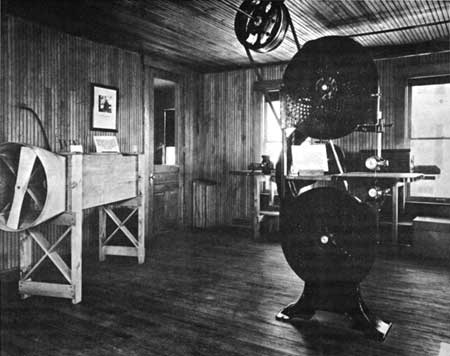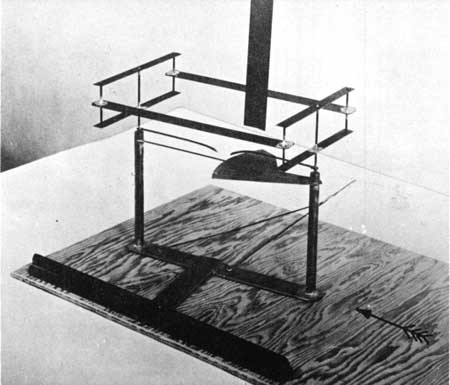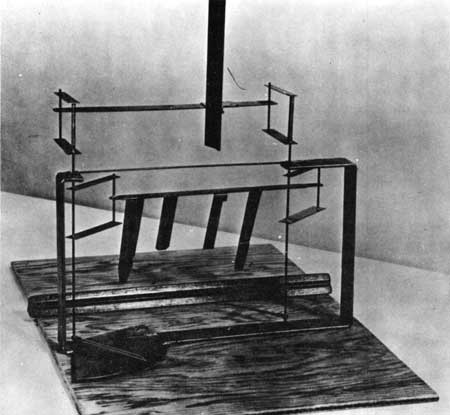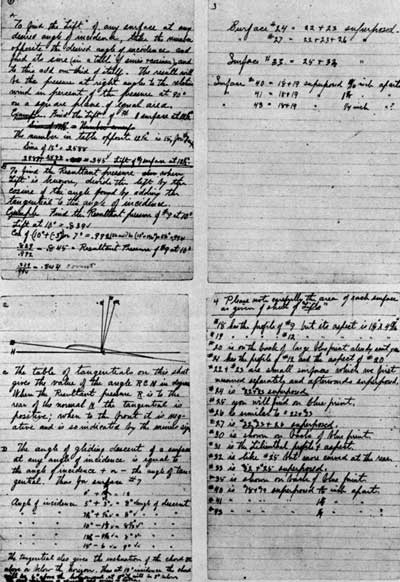|
WRIGHT BROTHERS National Memorial |
 |

A reproduction of the 1901 wind tunnel that the Wright
Brothers used in their shop at Dayton, Ohio. The narrow, metal-bladed
fan was belt-operated from the overhead line shafting (top center),
forcing a current of air through the tunnel at about 25 miles an hour.
This neat workroom is behind the Wright bicycle shop which was moved
from Dayton to Greenfield Village, Dearborn, Mich.
Wind Tunnel Tests, 1901
Shortly after their return to Dayton, the Wrights undertook a series of scientific experiments which produced knowledge that no one had possessed before and that contributed materially to their solution of the problem of powered flight. Disappointed by the relatively poor results achieved at Kitty Hawk with their 1901 glider, in the construction of which they had relied on Lilienthal's and other published tables of air pressures, the Wrights decided to start again from scratch by conducting laboratory tests of their own and by evolving their own air pressure tables from measurements made with model airfoils (miniature wing surfaces) using a simple but effective homemade wind tunnel.
Their second wind tunnel—the first was a makeshift affair hurriedly contrived by Orville out of a wooden starch box and was used for just a few days and then only in preliminary tests—consisted of an open end wooden box 6 feet long and 16 inches square (inside dimensions). Through this box-like tunnel a flat-bladed fan forced a current of air at a speed of about 25 miles an hour. The air entered the tunnel through a funnel-shaped metal section equipped with a honeycomb-type wind straightener to produce a uniform airflow. The most ingenious parts of the Wright wind tunnel were the two balances they designed for measuring the lift and drag of the model air-foils. Using these balances, the forces could be read as angles from a pointer moving over a protractor fixed to the floor of the tunnel.

The 1901 drift balance was used for measuring the drag ratio of Wright
model airfoils. This is a reproduction. The original balance is in the
Franklin Institute, Philadelphia.

Reproduction of lift balance used in 1901 wind tunnel; model airfoil in
testing position. The original balance is in the Franklin Institute.
In a period of about 2 months toward the close of 1901, the Wrights tested more than 200 surfaces. They measured monoplane, biplane, and triplane wing models. Among these shapes were models of the bird-like wing surfaces used by Lilienthal and the tandem arrangement (in which one wing followed the other) used by Langley. They measured lift and drag forces at various angles from 2° to 45° tangentials, gliding angles, and lift/drag ratios; they tested the effect of aspect ratio and the effect on lift of varying the camber of curvature of the surfaces, and tried a variety of shapes and thicknesses for the leading and trailing edges, for wing tips, and for such structural members as uprights.

1901 wind-tunnel data sent by Wilbur Wright to Octave Chanute,
Jan. 5 and 7, 1902, with instructions for making computations.
As a result of these experiments, all carefully carried out and minutely recorded, they obtained a body of data on air pressures and on the aerodynamic properties of wings, control surfaces, and structural parts. The extent and reliability of the information from these tests far exceeded anything that had ever been available to other experimenters or was to be available for at least another decade. Their friend and correspondent, Octave Chanute, marveled at the speed and accuracy with which this laboratory research was carried out.
The Wrights themselves soon came to realize that these scientific experiments, on which they had embarked with considerable reluctance, were in fact the most valuable part of all their work in that they gave them accounts and detailed knowledge on which to base the design of flying machines.
The wind-tunnel experiments concluded in December 1901 made it possible for the Wrights to abandon the trial-and-error method of construction that had gone into their 1900 and 1901 gliders and to solve the basic problem of the correct design for lifting wings. Now they were able to devote their time to the two other major problems that had to be solved before human flight could be accomplished: a system for obtaining full control in the air, and the addition of an engine and propellers to the aircraft.

|
|
Last Modified: Sat, Sep 28 2002 10:00:00 pm PDT |


